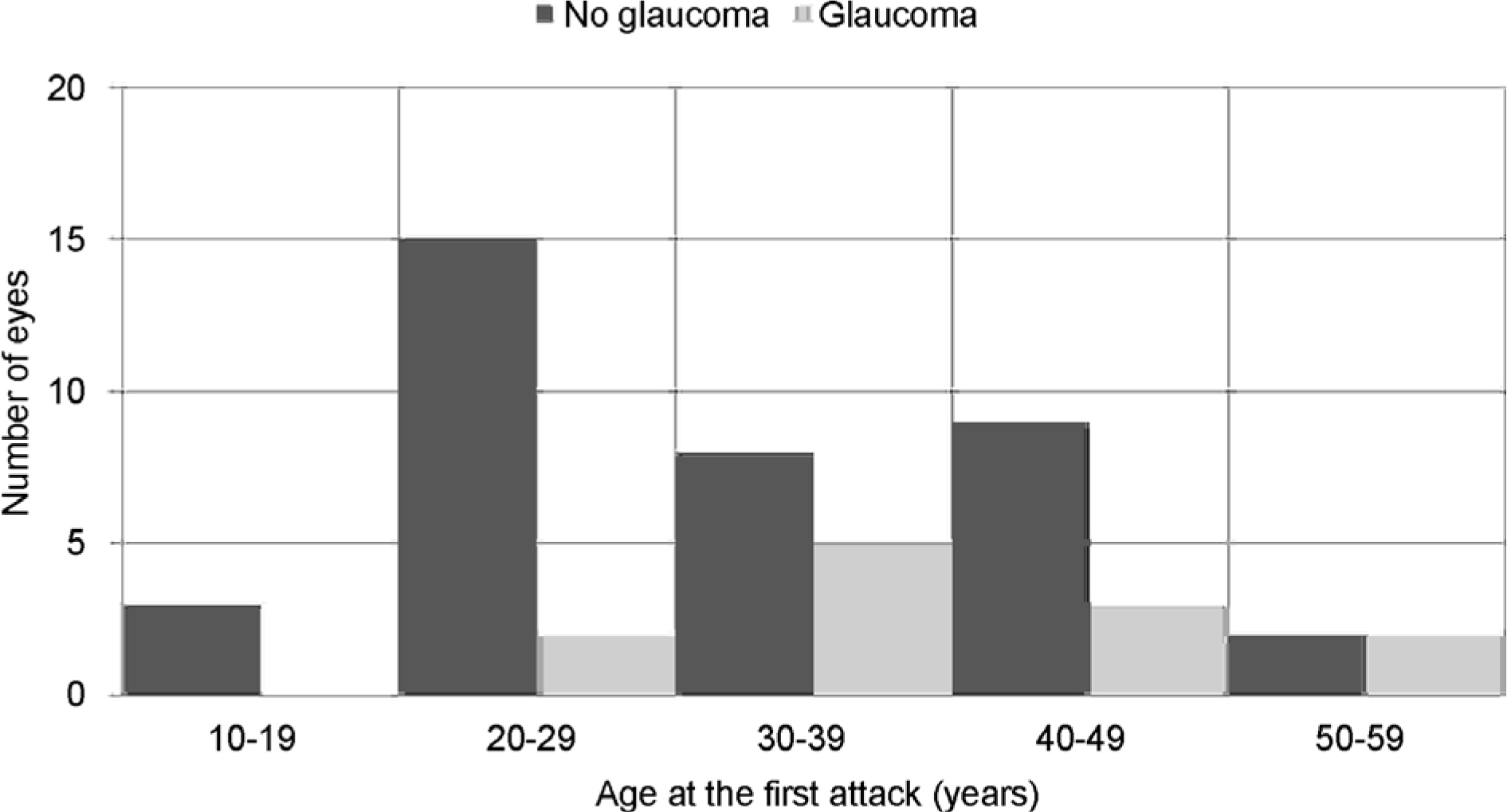J Korean Ophthalmol Soc.
2015 Jun;56(6):938-943. 10.3341/jkos.2015.56.6.938.
Clinical Features and Risk Factors of Glaucomatous Change in Posner-Schlossman Syndrome
- Affiliations
-
- 1Department of Ophthalmology, Samsung Medical Center, Sungkyunkwan University School of Medicine, Seoul, Korea. ckee@skku.edu
- KMID: 2339161
- DOI: http://doi.org/10.3341/jkos.2015.56.6.938
Abstract
- PURPOSE
To analyze the clinical features and determine the factors that affect glaucomatous change of patients with Posner-Schlossman syndrome (PSS).
METHODS
A retrospective analysis of 51 eyes of 51 patients diagnosed with PSS was performed. We analyzed the factors including age of first attack, highest intraocular pressure (IOP), duration of the disease, number of the attacks and interval between attacks among the patients who developed glaucoma and those who did not and compared the 2 groups.
RESULTS
The age of first attack was 34.73 +/- 10.77 years, and highest IOP was 47.75 +/- 9.43 mm Hg. Duration of the disease was 62.06 +/- 69.84 months, number of the attacks was 6.20 +/- 7.73 times, and interval between attacks was 12.65 +/- 8.95 months. Of 51 eyes of 51 patients, 12 eyes (23.5%) of 12 patients showed significant glaucomatous change. In the glaucoma group, highest IOP was 52.81 +/- 7.87 mm Hg, number of attacks was 11.91 +/- 10.63 times, and interval between attacks was 8.07 +/- 3.97 months. In the non-glaucomatous group highest IOP was 46.19 +/- 9.14 mm Hg, number of attacks was 4.59 +/- 5.94 times, and interval between attacks was 14.59 +/- 9.79 months, respectively. Highest IOP was significantly greater, number of attacks was higher, and interval was shorter with statistical significance in the glaucoma group (p = 0.025, p = 0.001, p = 0.028).
CONCLUSIONS
A significant number of patients with PSS tend to show glaucomatous change over time. Patients with high IOP during attacks and those having frequent attacks with short intervals should be closely monitored and evaluation for glaucomatous damage is recommended.
Keyword
Figure
Cited by 1 articles
-
Comparison of Clinical Characteristics between Patients with Cytomegalovirus Positive and Negative Hypertensive Uveitis
Jin-Ho Kim, Ji-Young Lee, Jin-A Choi
J Korean Ophthalmol Soc. 2020;61(3):258-266. doi: 10.3341/jkos.2020.61.3.258.
Reference
-
References
1. Posner A, Schlossman A. Syndrome of unilateral recurrent attacks of glaucoma with cyclitic symptoms. Arch Ophthal. 1948; 39:517–35.
Article2. Posner A, Schlossman A. Further observations on the syndrome of glaucomatocyclitic crises. Trans Am Acad Ophthalmol Otolaryngol. 1953; 57:531–6.3. Masuda K, Izawa Y, Mishima S. Prostaglandins and glaucomatocyclitic crisis. Jpn J Ophthalmol. 1975; 19:368–75.4. Raitta C, Vannas A. Glaucomatocyclitic crisis. Arch Ophthalmol. 1977; 95:608–12.
Article5. Yamamoto S, Pavan-Langston D, Tada R, et al. Possible role of herpes simplex virus in the origin of Posner-Schlossman syndrome. Am J Ophthalmol. 1995; 119:796–8.
Article6. Bloch-Michel E, Dussaix E, Cerqueti P, Patarin D. Possible role of cytomegalovirus infection in the etiology of the Posner-Schlossmann syndrome. Int Ophthalmol. 1987; 11:95–6.
Article7. Teoh SB, Thean L, Koay E. Cytomegalovirus in aetiology of Posner-Schlossman syndrome: evidence from quantitative polymerase chain reaction. Eye (Lond). 2005; 19:1338–40.
Article8. Spivey BE, Armaly MF. Tonographic findings in glaucomatocyclitic crises. Am J Ophthalmol. 1963; 55:47–51.
Article9. Hung PT, Chang JM. Treatment of glaucomatocyclitic crises. Am J Ophthalmol. 1974; 77:169–72.
Article10. Kass MA, Becker B, Kolker AE. Glaucomatocyclitic crisis and primary open-angle glaucoma. Am J Ophthalmol. 1973; 75:668–73.
Article11. Jap A, Sivakumar M, Chee SP. Is Posner Schlossman syndrome be-nign? Ophthalmology. 2001; 108:913–8.
Article12. Park WH, Jung YS, Han KS, Sohn YH. Clinical factors of glaucomatous change in patients with Posner-Schlossman syndrome. J Korean Ophthalmol Soc. 2005; 46:671–5.13. Caprioli J, Miller JM. Correlation of structure and function in glaucoma. Quantitative measurements of disc and field. Ophthalmology. 1988; 95:723–7.14. Sommer A, Pollack I, Maumenee AE. Optic disc parameters and onset of glaucomatous field loss. II. Static screening criteria. Arch Ophthalmol. 1979; 97:1449–54.15. Pederson JE, Anderson DR. The mode of progressive disc cupping in ocular hypertension and glaucoma. Arch Ophthalmol. 1980; 98:490–5.
Article16. Zeyen TG, Caprioli J. Progression of disc and field damage in early glaucoma. Arch Ophthalmol. 1993; 111:62–5.
Article17. Yamada N, Mills RP, Leen MM, et al. Probability maps of sequential glaucoma-scope images help identify significant change. J Glaucoma. 1997; 6:279–87.
Article18. Darchuk V, Sampaolesi J, Mato L, et al. Optic nerve head behavior in Posner-Schlossman syndrome. Int Ophthalmol. 2001; 23:373–9.
Article19. Kim TH, Kim JL, Kee C. Optic disc atrophy in patient with Posner-Schlossman syndrome. Korean J Ophthalmol. 2012; 26:473–7.
Article20. Mitchell P, Smith W, Attebo K, Healey PR. Prevalence of open-angle glaucoma in Australia. The Blue Mountains Eye Study. Ophthalmology. 1996; 103:1661–9.
Article21. Dielemans I, Vingerling JR, Wolfs RC, et al. The prevalence of primary open-angle glaucoma in a population-based study in The Netherlands. The Rotterdam Study. Ophthalmology. 1994; 101:1851–5.
Article22. Coleman AL, Miglior S. Risk factors for glaucoma onset and progression. Surv Ophthalmol. 2008; 53(Suppl 1):S3–10.
Article23. Suzuki Y, Iwase A, Araie M, et al. Risk factors for open-angle glaucoma in a Japanese population: the Tajimi Study. Ophthalmology. 2006; 113:1613–7.24. Leske MC, Wu SY, Hennis A, et al. Risk factors for incident open-angle glaucoma: the Barbados Eye Studies. Ophthalmology. 2008; 115:85–93.25. Kim M, Kim TW, Park KH, Kim JM. Risk factors for primary open-angle glaucoma in South Korea: the Namil study. Jpn J Ophthalmol. 2012; 56:324–9.
Article
- Full Text Links
- Actions
-
Cited
- CITED
-
- Close
- Share
- Similar articles
-
- Clinical Factors of Glaucomatous Change in Patients with Posner-Schlossman Syndrome
- A Case of Posner-Schlossman Syndrome with Retinal Arterial Tortuosity in a Young Male
- Point-of-care monitoring of perioperative intraocular pressure using portable tonometry in a patient with Posner-Schlossman syndrome: a case report
- A Case of Posner-Schlossman Syndrome following after Strabismus Surgery
- Optic Disc Atrophy in Patient with Posner-Schlossman Syndrome


